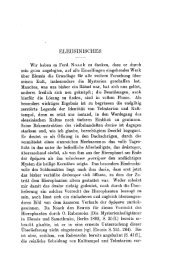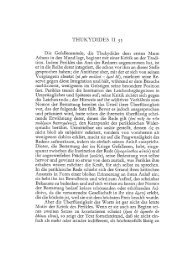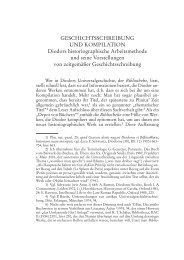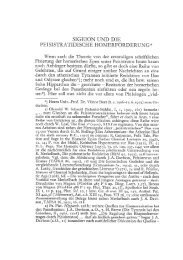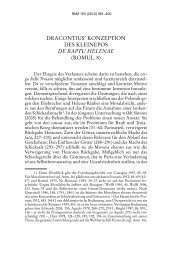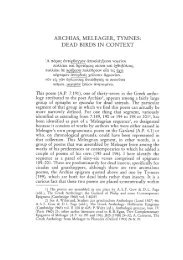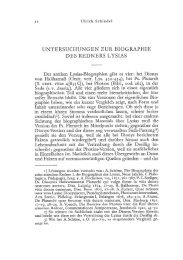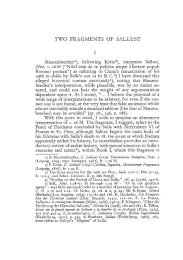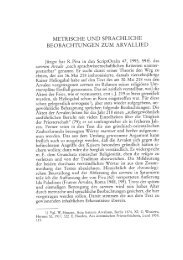VIRGILIO E STESICORO Una ricerca sulla Tabula Iliaca Capitolina *
VIRGILIO E STESICORO Una ricerca sulla Tabula Iliaca Capitolina *
VIRGILIO E STESICORO Una ricerca sulla Tabula Iliaca Capitolina *
Sie wollen auch ein ePaper? Erhöhen Sie die Reichweite Ihrer Titel.
YUMPU macht aus Druck-PDFs automatisch weboptimierte ePaper, die Google liebt.
198 David Wardle<br />
assessment and the word itself appears as a clear ‘rubric’, 54 whereas<br />
the case for urbs is less clear cut at first sight. 55 However, the divisio<br />
which introduces Divus Augustus 46, ad hunc modum urbe urbanisque<br />
rebus administratis, and which sums up the preceding 17<br />
chapters suggests strongly that urbs is the main unifying principle<br />
for the preceding material. If so, Burmann and his successors were<br />
justified in beginning a new paragraph with urbem ...excoluit, the<br />
link required by Ceausescu is weakened and the whole section on<br />
Augustus’ offices ends with powerful ipsissima verba of the princeps<br />
– Augustus declared his intention rem publicam retinere – and<br />
Suetonius adds his unstinting approval.<br />
In trying to pinpoint the date of Augustus’ edict, however, this<br />
is not much help and Suetonius’ words quam voluntatem, cum prae<br />
se identidem ferret, quodam etiam edicto ... testatus est, if identidem<br />
and the imperfect ferret are stressed, could suggest an extended<br />
period. Moreover, quodam (as opposed to, for example, illo)<br />
does not suggest any famous edict which we should link to a prominent<br />
historical event. Nonetheless, many scholars have proposed<br />
definite contexts for the edict, many connected with pivotal moments<br />
in Augustus’ reign: in 29 shortly after Octavian’s return from<br />
the East, 56 in 28, 57 13th January 27, when Octavian handed back his<br />
provinces to the Senate and people, 58 sometime in the summer of<br />
23, after the major medical crisis suffered by Augustus, 59 in 18 or<br />
54) E.g. Cal. 21, Cl. 20.1, Dom. 5.<br />
55) Cf. DJ 44: de ornanda instruendaque urbe . . . destinabat, Cl. 18.1: urbis<br />
annonaeque curam . . . egit.<br />
56) Girardet (above, n. 2) 231–2; 242: after 18th August but before autumn/<br />
winter 29.<br />
57) F. Martino, Storia della costituzione romana, vol. 4, Naples 1974, 149.<br />
John Rich has suggested to me that he would consider also the edict of 28 by which<br />
Octavian proclaimed the annulment of his illegal acts.<br />
58) Scott (above, n. 36) 46. For Magdelain (above, n. 40) 56–7, the dating of<br />
the edict is not problematic – as it mentions the intention to ‘rétablir la république’<br />
it cannot be after 13th January 27 B. C., when the announcement was made, and as<br />
his intention was only made public on that day it cannot be before it. Therefore<br />
it must be January 13th: “nous sommes donc en présence de l’Édit par lequel Auguste<br />
publia sa décision de restaurer la constitution républicaine”. Cf. Grenade<br />
(above, n. 36) 147: “édit qui doit dater du 13 janvier 27” and V. Fadinger, Die Begründung<br />
des Prinzipats, Berlin 1969, 326.<br />
59) Von Premerstein (above, n. 5) 124; G. E. F. Chilver, Augustus and the Roman<br />
Constitution 1939–50, Historia 1, 1950, 422; E. T. Salmon, The Evolution of<br />
Augustus’ principate, Historia 5, 1956, 458: “possibly in 23 B. C. although the year



